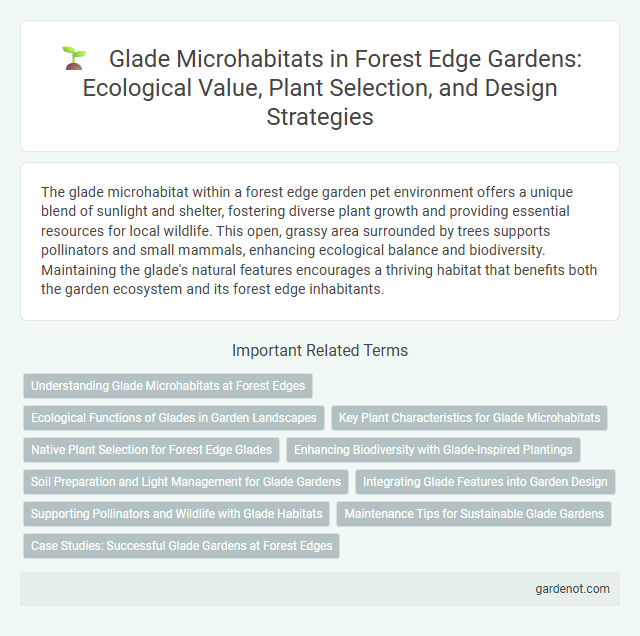The glade microhabitat within a forest edge garden pet environment offers a unique blend of sunlight and shelter, fostering diverse plant growth and providing essential resources for local wildlife. This open, grassy area surrounded by trees supports pollinators and small mammals, enhancing ecological balance and biodiversity. Maintaining the glade's natural features encourages a thriving habitat that benefits both the garden ecosystem and its forest edge inhabitants.
Understanding Glade Microhabitats at Forest Edges
Glade microhabitats at forest edges exhibit unique ecological conditions characterized by increased sunlight, variable moisture levels, and diverse soil composition that support specialized plant and animal species. These open, grassy areas create critical transitional zones promoting biodiversity by supporting both forest interior and open-area organisms. Understanding the microclimatic gradients and species interactions within glades is essential for effective conservation and management of forest edge environments.
Ecological Functions of Glades in Garden Landscapes
Glades in forest edge gardens serve as crucial microhabitats that enhance biodiversity by providing open spaces with increased sunlight, fostering diverse plant and animal species. These sunlit patches support pollinators and thermoregulating insects, promoting ecological balance and resilience within the garden ecosystem. Glades also facilitate nutrient cycling and seed dispersal, acting as vital ecological corridors that connect fragmented habitats.
Key Plant Characteristics for Glade Microhabitats
Glade microhabitats thrive with sun-tolerant, drought-resistant plants featuring deep root systems that anchor in thin, rocky soils. Species such as native grasses, wildflowers like coneflowers, and low shrubs exhibit adaptations including small, waxy leaves to minimize water loss and vibrant flowers to attract pollinators. These key plant characteristics promote biodiversity while maintaining the delicate balance of light and moisture typical of forest edge ecosystems.
Native Plant Selection for Forest Edge Glades
Native plant selection for forest edge glades emphasizes species adapted to partial sunlight and fluctuating moisture levels, such as woodland sunflowers (Helianthus divaricatus) and mayapple (Podophyllum peltatum). These plants support local biodiversity by providing habitat and food for pollinators like native bees and butterflies. Incorporating deciduous shrubs, including spicebush (Lindera benzoin), enhances ecological balance and soil health at the forest edge.
Enhancing Biodiversity with Glade-Inspired Plantings
Glade microhabitats, characterized by open spaces within forest edges, support diverse plant species that thrive under increased sunlight and reduced tree canopy. Introducing glade-inspired plantings such as native wildflowers, shrubs, and grasses enhances biodiversity by providing habitat and food sources for pollinators, birds, and small mammals. These plantings enrich soil health and ecological resilience, creating dynamic interfaces between dense forest and open garden environments.
Soil Preparation and Light Management for Glade Gardens
Glade microhabitats in forest edge gardens require well-drained, nutrient-rich soil with a slightly acidic pH between 5.5 and 6.5, achieved through organic matter incorporation such as compost or leaf mulch. Light management involves ensuring partial to full sun exposure, as glade plants typically thrive under filtered sunlight or dappled shade conditions. Careful pruning of surrounding vegetation promotes optimal light penetration, balancing the microhabitat's microclimate and supporting diverse understory flora.
Integrating Glade Features into Garden Design
Incorporating Glade microhabitat features into forest edge garden design enhances biodiversity by creating open, sunlit spaces that support diverse plant and animal species. Strategic placement of native grasses, wildflowers, and low shrubs mimics natural glade conditions, promoting pollinators and ground-nesting birds. Designing pathways and seating areas within these clearings encourages ecological interaction while maintaining habitat integrity.
Supporting Pollinators and Wildlife with Glade Habitats
Glade microhabitats within forest edge gardens create open, sunlit spaces that support diverse pollinators such as bees, butterflies, and hoverflies by providing abundant flowering plants and nesting sites. These clearings enhance biodiversity by offering essential resources like nectar, pollen, and shelter, fostering healthy populations of pollinators and wildlife. Maintaining glades promotes ecosystem resilience and encourages natural pest control through increased presence of beneficial insects.
Maintenance Tips for Sustainable Glade Gardens
Regularly remove invasive species to preserve native plant diversity and prevent ecosystem imbalance in glade microhabitats. Implement controlled burning or mowing practices during dormant seasons to maintain open, sunny conditions essential for glade flora. Monitor soil moisture levels and avoid excessive irrigation, ensuring optimal water conditions that support drought-tolerant species and promote sustainable garden health.
Case Studies: Successful Glade Gardens at Forest Edges
Case studies of successful glade gardens at forest edges demonstrate the importance of selecting native plant species that thrive in partial sunlight and well-drained soils typical of these microhabitats. Notable examples include the Blue Ridge Mountains glade gardens, where a mix of wildflowers such as Trillium and native grasses support local pollinators and increase biodiversity. Effective management strategies in these case studies emphasize minimal disturbance and the promotion of natural regeneration to maintain the ecological balance at forest margins.
Glade microhabitat Infographic

 gardenot.com
gardenot.com